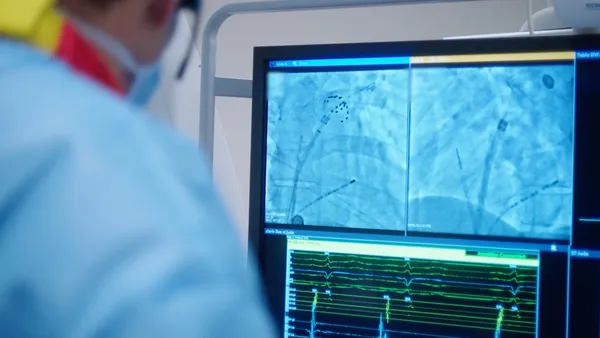Dive Brief:
- ViewRay this week reported three-month results from the first prospective clinical trial of magnetic resonance-guided radiation therapy (MRgRT) in 101 patients with localized prostate cancer.
- The Cleveland, Ohio-based company manufactures the MRIdian system, designed to integrate high-definition MR imaging, radiation delivery and software to help doctors better understand the location and shape of soft tissue tumors, thereby increasing precision of radiation and avoiding harm to healthy tissues.
- The combination of high magnetic fields and radiation therapy creates concern for the potential of beam distortion and skin toxicity, ViewRay explains. In the recent study of intermediate- and high-risk prostate cancer patients, researchers from Amsterdam University Medical Centers observed low incidence of early gastrointestinal (GI) and genitourinary (GU) toxicity in patients undergoing the MR-guided therapy.
Dive Insight:
Founded in 2004, ViewRay went public in 2015 and holds 510(k) clearances for variations of its MRIdian Linac System. A LINAC system is a medical linear accelerator, the most commonly used equipment for external beam radiation treatments for cancer.
The company said the MR-guidance feature of the system eliminated the need for the trial to incorporate implanted markers or tissue spacers. The results in the intermediate- and high-risk groups are comparable to outcomes in lower-risk populations, the company also said.
"The strong results and minimal toxicity levels should further validate MRIdian's on-table adaptive and beam gating capabilities, and adds to the growing body of evidence of the system's superior clinical and safety profile," analysts at Baird wrote to investors Aug. 20, noting that although one-year follow-up data will not likely be published until mid-2020, prior studies of large prostate-focused external beam radiotherapy have shown higher toxicities.
"It's studies like this, the company-sponsored pancreatic study that's currently underway, and others from VRAY's clinical partners evaluating the safety and efficacy of MRgRT applied to varying tumor sites (breast, oligometastases of the spine, NSCLC, head and neck, etc.) that we believe will go a long way in further building category interest for MRgRT and make MRIdian the MR linac system of choice," the analysts added.
The results were published in the American Society for Radiation Oncology's International Journal of Radiation Oncology, Biology and Physics.
The news comes a few weeks after the company delivered a disappointing second quarter financial update Aug. 8. Executives dropped revenue expectations from the range of $111 million to $124 million to between $80 million to $95 million, while raising anticipated cash usage from the range of $65 million to $75 million to between $80 million and $90 million.
"We are disappointed to take down guidance for the year, but we believe it is prudent given the timing of installations around year-end," CEO Scott Drake said in a prepared statement. "We remain focused on the long-term opportunity versus short term variability and are confident that we will demonstrate the momentum of our growing pipeline and end-user demand moving forward."
ViewRay also announced its CFO of three years, Ajay Bansal, will leave the company at the end of September.
"All that could go wrong went wrong in 2Q," analysts at Jefferies wrote to investors Aug. 9, noting fewer than expected orders during the quarter amid pressures like elongated purchasing cycles and pricing competition from Swedish competitor Elekta.
Still, the analysts said the stock sell-off following the earnings report was overblown, calling MRIdian "well positioned for eventual share gains on the benefits imaging/adaptability/dosing can bring to patient outcomes."












